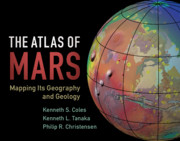Book contents
- The Atlas of Mars
- Additional material
- The Atlas of Mars
- Copyright page
- Table of Contents
- Preface
- Acknowledgments
- Abbreviations
- How to Use this Atlas
- Sources of Images
- Chapter 1 Introduction
- Chapter 2 History of Exploration of Mars
- Chapter 3 Global Character of Mars
- Chapter 4 Regional Geographic Features and Surface Views of Mars
- Chapter 5 Geology of Mars
- Map Sheets
- Mare Boreum (MC-1)
- Diacria (MC-2)
- Arcadia (MC-3)
- Mare Acidalium (MC-4)
- Ismenius Lacus (MC-5)
- Casius (MC-6)
- Cebrenia (MC-7)
- Amazonis (MC-8)
- Tharsis (MC-9)
- Lunae Palus (MC-10)
- Oxia Palus (MC-11)
- Arabia (MC-12)
- Syrtis Major (MC-13)
- Amenthes (MC-14)
- Elysium (MC-15)
- Memnonia (MC-16)
- Phoenicis Lacus (MC-17)
- Coprates (MC-18)
- Margaritifer Sinus (MC-19)
- Sinus Sabaeus (MC-20)
- Iapygia (MC-21)
- Mare Tyrrhenum (MC-22)
- Aeolis (MC-23)
- Phaethontis (MC-24)
- Thaumasia (MC-25)
- Argyre (MC-26)
- Noachis (MC-27)
- Hellas (MC-28)
- Eridania (MC-29)
- Mare Australe (MC-30)
- Moons: Phobos and Deimos
- Appendix
- Gazetteer
- References
- Index
Oxia Palus (MC-11)
from Map Sheets
Published online by Cambridge University Press: 16 August 2019
- The Atlas of Mars
- Additional material
- The Atlas of Mars
- Copyright page
- Table of Contents
- Preface
- Acknowledgments
- Abbreviations
- How to Use this Atlas
- Sources of Images
- Chapter 1 Introduction
- Chapter 2 History of Exploration of Mars
- Chapter 3 Global Character of Mars
- Chapter 4 Regional Geographic Features and Surface Views of Mars
- Chapter 5 Geology of Mars
- Map Sheets
- Mare Boreum (MC-1)
- Diacria (MC-2)
- Arcadia (MC-3)
- Mare Acidalium (MC-4)
- Ismenius Lacus (MC-5)
- Casius (MC-6)
- Cebrenia (MC-7)
- Amazonis (MC-8)
- Tharsis (MC-9)
- Lunae Palus (MC-10)
- Oxia Palus (MC-11)
- Arabia (MC-12)
- Syrtis Major (MC-13)
- Amenthes (MC-14)
- Elysium (MC-15)
- Memnonia (MC-16)
- Phoenicis Lacus (MC-17)
- Coprates (MC-18)
- Margaritifer Sinus (MC-19)
- Sinus Sabaeus (MC-20)
- Iapygia (MC-21)
- Mare Tyrrhenum (MC-22)
- Aeolis (MC-23)
- Phaethontis (MC-24)
- Thaumasia (MC-25)
- Argyre (MC-26)
- Noachis (MC-27)
- Hellas (MC-28)
- Eridania (MC-29)
- Mare Australe (MC-30)
- Moons: Phobos and Deimos
- Appendix
- Gazetteer
- References
- Index
Summary
The Oxia Palus quadrangle is dominated in the east by the mid-elevation Arabia Terra (1,500–3,500 m below datum), with ancient cratered terrain transitioning from the southern highlands down to the northern plains. Arabia Terra includes a portion of Meridiani Planum, north of the Mars Exploration Rover-B (Opportunity) landing site (MC-19). Mawrth Vallis is the only large valley coming from this portion of Arabia Terra that has a mouth opening directly into the northern plains across the dichotomy boundary. The western half of the quadrangle includes portions of Margaritifer Terra and Xanthe Terra highland terrains, which are dissected by enormous outflow channels. These formed by catastrophic floods that left behind grooved channels, streamlined islands, chaotic terrain, braided-channel patterns, and the southern margin of the smooth northern plains deposits. From east to west, Ares, Tiu, Simud, and Shalbatana Valles carve curvilinear paths through the highland terrain until merging at the southern margins of Chryse Planitia. Chryse, at 3,000–4,000 m below datum, dominates the northwest portion of the quadrangle and lies within an ~1,600-km-diameter, ancient, largely degraded, and buried impact basin. The Mars Pathfinder landing site, which included the first rover (named Sojourner) to navigate on Mars, is located in Tiu Valles near the edge of the Ares Vallis deposits.
- Type
- Chapter
- Information
- The Atlas of MarsMapping its Geography and Geology, pp. 126 - 131Publisher: Cambridge University PressPrint publication year: 2019



